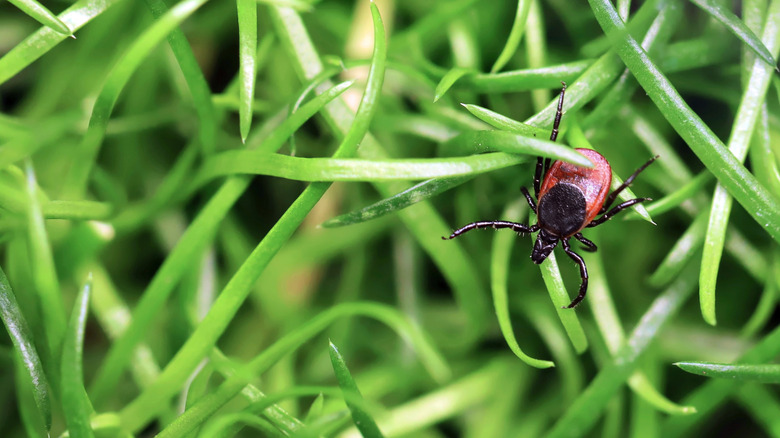Why Your Lawn Maintenance Routine May Actually Be Attracting Ticks To Your Yard
When you're soaking up the sunshine in your yard, the last thing you want to have to think about is ticks. On the surface, it makes sense to think that keeping a tidy lawn would also keep it more bug-free — particularly tick-free — than letting native plants grow wild. But it turns out that the opposite is true: having a biodiverse lawn full of native plants can actually keep ticks out of your yard.
Some aspects of keeping a neat yard do help with tick prevention, like keeping leaf litter to a minimum or having landscaped areas of mulch or stone since ticks don't like to cross dry zones. You may have heard the advice to keep grass trimmed to under 3 inches, but as it turns out, that one may be a myth; a 2019 study published in the Public Library of Science found that mowing the lawn does little to affect ticks, but it could be negatively affecting the important pollinators visiting your yard.
Ticks are resilient little bugs that can even survive cold winter days, so having a lawn devoid of native plants won't be enough to keep them out. It's actually more likely to have an adverse effect, as this approach keeps away the wildlife that would keep tick populations under control. The solution lies in increasing the variety of flora and fauna in your yard, also known as biodiversity.
How a biodiverse lawn keeps ticks away
Ticks are more than just annoying — they also carry disease. Ticks are known as vector pests, meaning they can spread sickness including Rocky Mountain spotted fever, babesiosis, ehrlichiosis, and Lyme disease. Biodiversity can minimize the spread of ticks and tick-borne illnesses through what's known scientifically as the dilution effect.
Here's how it works: in a manicured and native plant-free lawn, the nearest enticing thing for ticks to bite is either another pest (like mice) or you. With biodiversity, more wildlife will be attracted to the area, so ticks have other options to bite species that are less reservoir-competent, meaning they're less likely to carry and transmit disease. The introduction of new host animals is diluting the likelihood of ticks infecting more susceptible living things, including you.
The other way lawns with diverse native plant life can affect tick populations is by encouraging more wildlife to the area that feeds on creatures that spread ticks. For example, mice can thrive even in lawns with less biodiversity. They're also a great vector for Lyme disease, which causes the perfect storm for propagating ticks and their infections. Growing the right plants can attract snakes, owls, foxes, and other natural predators to keep mice in check, which in turn keeps the ticks infecting the mice in check. Plus, with more of an established ecosystem on your lawn, outsider species are less likely to infiltrate and cause an imbalance that lets ticks run amok.
How to create a biodiverse lawn
If your yard is so neat that it looks like a golf course, how do you biodiversify it? The secret anti-tick weapon is to use native plants. Native plants are what they sound like: plants that have been growing naturally in your area for thousands of years, meaning they're perfectly suited to thrive in your yard and garden, and often with less care than non-native plants. Because native plants are already adapted to their environment, they typically need less fertilizer, and require less watering and pesticides than lawns. Some are even keystone plants, which are especially important to their local environment as sources of food and attractants for pollinators.
Which native plants will best suit your yard varies based on location and climate, but it's easy to find recommendations if you search "native plants" along with your state's name online. There are plant finder tools that let you search by zip code, such as the resource created by the National Wildlife Federation. Choose multiple favorites, since the "diversity" part of biodiversity requires variation. And, as extra credit, consider choosing plants that have an added bonus of deer resistance since deer are a common source of ticks.


